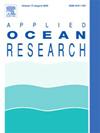功率优化建模作为波浪能变换器功率起飞设计的计算工具
IF 4.4
2区 工程技术
Q1 ENGINEERING, OCEAN
引用次数: 0
摘要
本研究提出了一种称为功率输出优化建模(POM)的计算工具,这是一种优化波能转换器(WECs)中功率输出(PTO)设计参数的方法。POM采用一种基于差分进化多目标方法的控制优化算法,在最小化设计成本的同时,最大限度地提高电功率。该方法在时域中集成了波到线(W2W)模型,包括PTO损耗模型。它还考虑了wcs运行的海况,以及与PTO额定力相关的限制。这些功能允许对产生的电能和PTO设计参数的优化进行全面评估。POM已应用于一个实际案例研究,该案例涉及在不同海况下运行的基于线性发电机的PTO。分析包括四种WEC技术和两种海况,以评估该工具的有效性。结果表明,PTO长度不仅影响资本支出的最小化,而且影响模块化系统的优化设计。此外,灵敏度分析表明,满足力要求所需的模块数量不受PTO效率的显著影响。总而言之,POM是技术开发人员和研究人员的多功能支持工具,有助于优化PTO设计,以平衡WEC制造成本和产生的功率。本文章由计算机程序翻译,如有差异,请以英文原文为准。
Power optimization modelling as a computational tool for power take off design in wave energy converters
This study presents a computational tool called Power Take-Off Optimisation Modelling (POM), a methodology for optimizing the design parameters of the Power Take-Off (PTO) in wave energy converters (WECs). POM uses a control optimization algorithm based on a differential evolution multi-objective approach to maximize the electrical power extracted by WECs while minimizing design costs.
The methodology integrates a wave-to-wire (W2W) model in the time domain, including a PTO loss model. It also considers the sea states where WECs operate, and constraints related to the PTO rated force. These features allow a comprehensive evaluation of the electrical energy generated and the optimization of PTO design parameters.
POM has been applied to a real case study involving a linear generator-based PTO operating under different sea states. The analysis includes four WEC technologies and two sea states to assess the tool’s effectiveness.
Results show that PTO length influences not only CAPEX minimization but also optimal modular system design. Additionally, a sensitivity analysis indicates that the number of modules required to meet force requirements is not significantly affected by PTO efficiency.
In conclusion, POM is a versatile support tool for technology developers and researchers, helping optimize PTO design to balance WEC manufacturing costs and generated power.
求助全文
通过发布文献求助,成功后即可免费获取论文全文。
去求助
来源期刊

Applied Ocean Research
地学-工程:大洋
CiteScore
8.70
自引率
7.00%
发文量
316
审稿时长
59 days
期刊介绍:
The aim of Applied Ocean Research is to encourage the submission of papers that advance the state of knowledge in a range of topics relevant to ocean engineering.
 求助内容:
求助内容: 应助结果提醒方式:
应助结果提醒方式:


